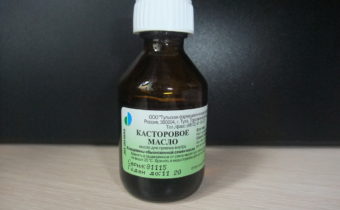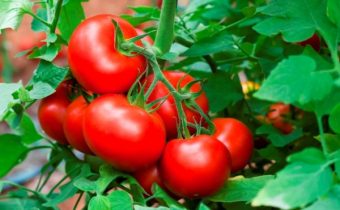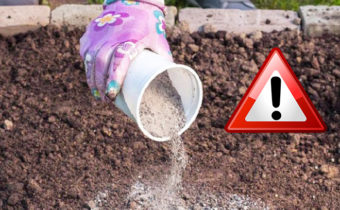Tomato "Lyubasha F1": ultra early with great popularity
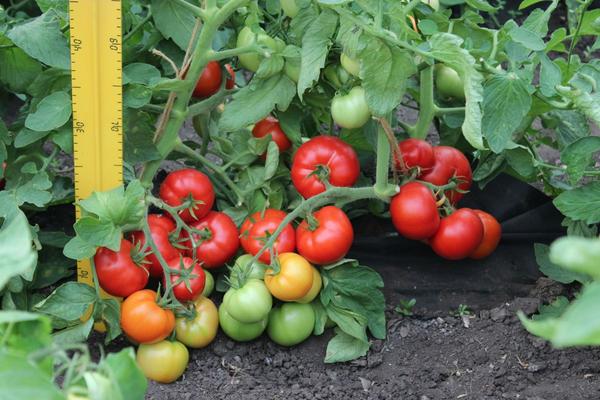
 This ultra early hybrid was bred recently by Russian breeders, but has already gained popularity. After sowing seeds, ripening occurs within 78-80 days.
This ultra early hybrid was bred recently by Russian breeders, but has already gained popularity. After sowing seeds, ripening occurs within 78-80 days.
The plant is well fruited in greenhouses and garden beds. It is resistant to many diseases of tomatoes. The yield for early varieties is high - 11-15 per sq.m.
Hybrid description
Tomato forms bushes of medium size - up to 1m. The plant is determinant. Despite the small height, the garter to the support is necessary, as the bushes abundantly bear fruit. Hybrid form in 2-3 stalks.
Close in size fruits ripen fairly amicably, their characteristics:

- The weight of tomatoes ranges from 200g for the first fruit, to 120 for the next.
- Form rounded, slightly flattened.
- The color of ripe fruit is rich, bright red.
- The surface is smooth, the skin is dense.
- Tomatoes are not prone to cracking.
- The flesh is juicy, excellent taste.
- Well preserved, not afraid of long shipments.
- The use of tomatoes is universal: they are good fresh, in salads, in combination with other vegetables, perfectly processed into juices and ketchups. They can be canned and frozen.
Diseases and pests
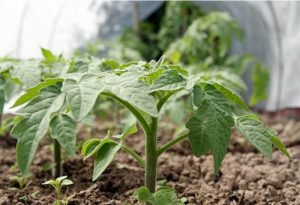 For tomatoes Lubash f1, as well as for most hybrids, is characterized by increased resistance to most fungal and viral diseases, including apical rot of fruit, tobacco mosaic virus, late blight and Alternaria.
For tomatoes Lubash f1, as well as for most hybrids, is characterized by increased resistance to most fungal and viral diseases, including apical rot of fruit, tobacco mosaic virus, late blight and Alternaria.
The early ripening of these tomatoes allows you to avoid many other diseases that overtake plants with the advent of cold snaps. If you follow the rules of agricultural engineering - watering, feeding, weeding, loosening the soil and airing the greenhouses in a timely manner (if the plants are grown in greenhouses), then no additional treatments with drugs will be required.
Terrestrial pests - slugs, Colorado potato beetle, mites fight mostly also without the use of chemistry - with the help of scaring decoctions of wormwood, garlic, bitter pepper, birch tar solution mixed with a solution of household soap. If the pests are few, they are harvested by hand and destroyed.
To control pests that gnaw up the root system, such as crunches and wireworms, it is necessary to carry out deep digging of the soil before planting. Otherwise, it will be possible to detect pests when the roots of the plant are already damaged.
Advantages and disadvantages
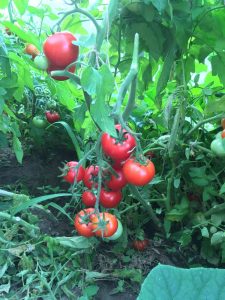 The new tomato variety Lyubasha attracts more and more fans with its qualities. Most of them note its inherent advantages:
The new tomato variety Lyubasha attracts more and more fans with its qualities. Most of them note its inherent advantages:
- Early ripening.
- Unpretentiousness of plants, resistance to diseases.
- Perfect for a hybrid fruit flavor.
- High yield, which sometimes reaches up to 4 kg per bush.
- Fruit uniformity.
- Good keeping quality and transportability.
- Versatility in use.
The disadvantage is the need to tie the stems to the support, the formation of plants in 2-3 stems, as well as pasynkovaniya.
See also: Features varieties of tomato "Tretyakov f1" and proper care of him
Features agrotehnika
Seedling preparation
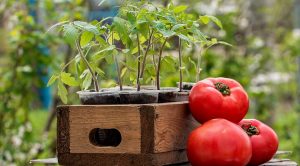 Preparation for a sowing campaign can be begun with preparation of soil for seedling. Trade offers different mixes for all plants and for specific crops. You can prepare the soil on your own - mix garden soil with peat and compost, add ash.
Preparation for a sowing campaign can be begun with preparation of soil for seedling. Trade offers different mixes for all plants and for specific crops. You can prepare the soil on your own - mix garden soil with peat and compost, add ash.
Tomatoes love a light, breathable soil, so if garden soil is composed of clay, it is mixed with sand, or sawdust for loosening. The prepared mixture is disinfected with a solution of potassium permanganate. Then seed is treated:
- In disinfectant solutions of potassium permanganate or phytosporin for 20 min.
- In growth stimulants or trace element solutions for 5-6 hours.
Tara (boxes, boxes) for planting seedlings are made with drainage holes to avoid stagnant water. If the container is not used the first year, it is also treated with disinfectant solutions.
The treated seeds are sown in a moist soil after 2-3 cm, then covered with a layer of earth (5-7mm), slightly compacted, covered loosely with a film or a lid and cleaned into a room with an air temperature of 23-25 degrees.
The soil in the seedling boxes must be kept in a slightly damp state, but it must not be allowed to stick to the roots. Watering is preferable to hold warm water.
The first two weeks from the moment the shoots appeared, the seedlings are subjected to a little stress - hardening. To do this, plants are exposed to closed verandas or balconies on which lower temperatures are maintained — about 15–16 degrees during the day, 12–14 degrees at night. Then return to comfortable conditions - 22-24 degrees.
Watering in the following days is combined with fertilizing with special fertilizers for seedlings with trace elements. With the appearance of the third true leaf, the tomatoes are planted in larger boxes at a distance between plants of 15-20 cm or in separate pots, cups.
With the onset of warm days, plants can be gradually adapted to the sun's rays — carried out on open verandas, into greenhouses.
Caring for plants in the ground
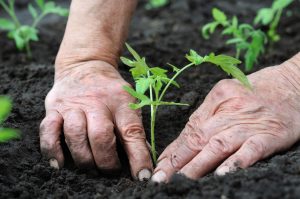 In order for the plants in the beds and in the greenhouse to grow healthy, it is important to prepare the soil in advance. The place for planting should be chosen taking into account its predecessors - the crops that grew on the site in previous years.
In order for the plants in the beds and in the greenhouse to grow healthy, it is important to prepare the soil in advance. The place for planting should be chosen taking into account its predecessors - the crops that grew on the site in previous years.
For 3 years, tomatoes can not be returned to the place where they grew tomatoes themselves or other nightshade, and their best predecessors are pumpkin - zucchini, cucumbers, as well as beets, carrots and legumes.
If plantings are planned in the greenhouse, the preparation is carried out from autumn:
- After harvesting, free from plant debris, weeds.
- Wash walls, racks, all inventory with a disinfectant solution.
- Cultivate the land with phytosporin or a solution of potassium permanganate.
- Lime soil.
- The healthy cultures are sown before winter.
Planting tomatoes in open ground and greenhouses are engaged with the arrival of sustainable heat.
In the greenhouse or in the open ground before planting seedlings mark pits, at the rate of 4-5 plants per 1 square meter, lay in them compost, ashes. The soil is plentifully watered before planting.
Planting plants in the ground is best in cloudy weather or in the evening, if the weather is hot and sunny, young plants should be pritenized.
After planting, plants are supported, to which plants will be tied up as they grow.
See also: Why are the leaves curled around a tomato in a greenhouse?
To save time and effort, many vegetable growers plant all their seedlings in a greenhouse (more compactly), from where they gradually transplant in 2-3 weeks in open ground.
After planting, plants do not touch for several days, and then leaving is reduced to the usual procedures:
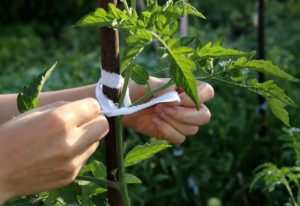
- Watering with warm water. Watering is carried out directly under the root of the plant, avoiding contact with the leaves, as in sunny weather it can cause burns. Good results are obtained by watering in containers located near the roots and drip irrigation.
- Weeding and loosening. Loosening has a very beneficial effect on tomatoes, as this creates additional roots.
- Feeding. The first feeding is carried out not earlier than 7-10 days after planting with green manure - diluted with a ratio of 1:10 with infusion of fermented grass. After the appearance of the ovaries, phosphorus-potassium fertilizers are added. It is important to feed after watering or rain. Feeding is carried out every 2-3 weeks, depending on the state of the plants.
- Soil mulching. Mulching allows you to keep the soil moist, does not allow weeds to grow. The use of grass and weeds as mulch over time (when rotting) enriches the soil with nitrogen fertilizers.
- Formation of plants, garters to supports and pasynkovanyu. According to some recommendations for the formation of a tomato, 2-3 stalks are left for plants, however, experimenters suggest forming Lyubasha shrubs even into 4 stalks, which only adds to yield.
- When growing tomatoes in the greenhouse, it is not allowed to over-humidify the air, as this may cause a splash of fungal diseases. Humidity reduction is achieved by opening the vents and doors. In this case, we must not forget that tomatoes do not tolerate drafts.
See also: Tomatoes "Mikado": pink, black, gold, yellow and red
In the opinion of lovers, by growing tomatoes of the Lyubash variety even on a balcony or veranda, you can also get a good harvest, which differs a little from the usual one - in the garden.
Video: Ultra Early Lyubasha Tomato


